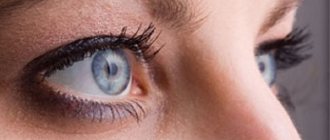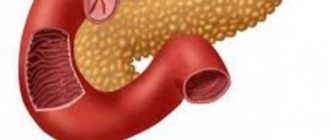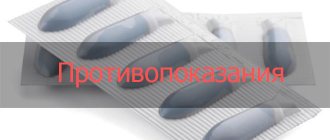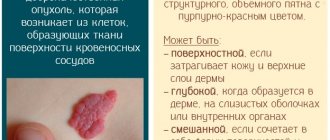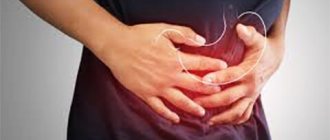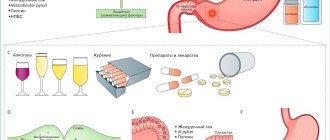The cerebrospinal fluid in the brain is renewed up to 7 times a day. Its constant volume is normally about 1 liter. If for some reason the circulation of the cerebrospinal fluid is disrupted, it begins to exert pressure, causing deformation and atrophy of the brain tissue. Intracranial pressure can change throughout the day, while the person does not feel discomfort; the condition is considered pathological when it becomes persistent.
Symptoms of increased intracranial pressure
ICP can occur in adults and children; according to medical data, it occurs more often in women. Normally, cranial pressure in an adult is up to 15 mmHg, in childhood it is lower.
Important information
An increase to 25-30 mm is considered critical, which can lead to irreversible consequences. If the condition is not normalized in a timely manner, brain death occurs.
Indicators can only be measured in a hospital setting, for this reason it is important to know the symptoms that manifest themselves:
- frequent headaches, especially in the morning or at night;
- absent-mindedness, lethargy, drowsiness;
- mood swings;
- pain in the spine;
- nausea and vomiting;
- increased sweating;
- tachycardia;
- deterioration of vision (double vision, blurred vision of objects, attacks of blindness, decreased reaction to light, the appearance of fog before the eyes);
- bruises and bruises under the eyes, changes in the shape of the eyeball;
- impaired joint mobility;
The main signs of ICP are blurred vision and headache, which covers the entire area, in contrast to migraine, which is localized on one side. The pain intensifies with turns, sudden movements and is not eliminated by taking analgesics. In children, the condition may manifest:
- visual increase in head size;
- involuntary eye movement;
- enlargement of the fontanel;
- convulsions;
- protrusion of blood vessels on the head;
- parents will be able to notice developmental delays in comparison with peers;
- the baby will burp frequently and gain little weight;
- behavior will become restless, lethargic and drowsy;
- the child's gaze will be directed not in front of him, but downward.
If ICP appears as a result of head injuries, the person will experience impaired consciousness, drowsiness, and possible fainting. The appearance of such symptoms may indicate other diseases, however, it should be a mandatory reason to consult a doctor. Hypertension is diagnosed by:
- General blood test.
- MRI or CT.
- Lumbar puncture.
- Laboratory examination of cerebrospinal fluid.
ICP is measured by catheter and connection to sensors or by spinal tap.
Diagnostics
The degree of ICH, depending on the value of intracranial pressure, is divided into:
- Normal (3-15 mm Hg).
- Weak (16-20 mm Hg).
- Average (21-30 mmHg).
- Pronounced (31-40 mm Hg).
- Strongly expressed (above 41 mm Hg).
Intracranial hypertension develops due to:
- Formation of additional volumes.
- Neoplasms.
- Hemorrhages (hematomas).
- Abscesses.
- Aneurysms.
- Cysts (parasitic, post-infectious), ventriculitis.
- Brain edema caused by infection, autoimmune, endocrine, metabolic diseases.
- Increased production of cerebrospinal fluid.
- Inflammatory diseases (meningitis, encephalitis).
- Endothelial tumors (epindymomas, choroid plexus papillomas).
- Impaired absorption and evacuation of CSF from the ventricular system during occlusion of its various parts.
- Tumors, cystic formations.
- Thrombosis.
- Adhesive process.
- Storage diseases (Niemann-Pick).
- Disturbances in the outflow of blood from the cranial cavity.
- Compression of veins due to craniostenosis.
- Osteochondrosis of the C3-C7 area.
- Consequences of head injury, meningitis, metastatic lesions of the meninges.
Approximate scope of diagnostic measures for a patient with ICH:
- examination by a neurologist;
- MRI or CT scan of the brain;
- consultation with an ophthalmologist;
- perimetry;
- fundus photograph;
- examination by a neurosurgeon;
- lumbar puncture;
- electroencephalography;
- angiography of head vessels;
- cerebrospinal fluid analysis;
- general clinical examinations of blood, urine, biochemistry;
- Ultrasound of the abdominal organs, pelvis, kidneys;
- chest x-ray;
- if necessary, examination by a therapist, cardiologist, endocrinologist;
- according to indications – positron emission tomography.
Causes of increased pressure
The cause of increased intracranial pressure is impaired absorption, stagnation or increased circulation of cerebrospinal fluid. The condition is secondary, it is caused by the following reasons:
- mechanical damage to the skull and brain;
- inflammation (encephalitis, meningitis);
- obesity;
- hypertension;
- hyperthyroidism;
- malfunction of the adrenal glands;
- liver pathologies;
- osteochondrosis of the cervical spine;
- tumors on the head;
- abscesses, cysts, helminthiasis, otitis, bronchitis, mastoiditis, malaria, stroke;
- taking certain medications.
Causes of ICP can also include genetic predisposition. In infants, the condition can be triggered by trauma during birth, hypoxia, toxicosis and prematurity.
Tablets to lower intracranial pressure in adults
Treatment for intracranial pressure depends on the extent and severity of the disease. Therapy includes: medications, physiotherapy, massage, acupuncture, physical therapy, diets, folk remedies, operations. You can bring your blood pressure back to normal by physical exercise and running with proper breathing.
Helpful information
It is worth considering that normalization will take time, the first results may appear only after 6 months.
In most cases, tablets for intracranial pressure of different groups are prescribed:
- Diuretics. Tablets from the group of diuretics for ICP are prescribed more often than other drugs. Medicines have a diuretic effect, which helps reduce blood pressure. The most prescribed are: Furosemide, Lasix, Hypothiazide, Diacarb, Glycerol, Mannitol, Eufillin.
- Vasodilators. The medications lower blood pressure by promoting fluid flow to the brain. Injections of nicotinic acid have a quick effect, treatment can be carried out with: Actovegin, Cinnarizine, Sermion, Phenotropil, Aspirin, Glycine, Bilobil, Pantogam.
- Vasoactive agents. Tablets for intracranial pressure help dilate blood vessels, improve blood circulation, and reduce pressure. They cope well with the symptoms: Magnesia, Cavinton, Sermion, Nicergoline.
- Medicines for headaches. Pain syndrome is relieved with: Analgin, Aspirin, Paracetamol, Ibuprofen, Citramon, Ibuklin, Nurofen, Solpadein, Pentalgin. It is possible to prescribe beta blockers: Coriol, Atenolol, Tenorik, Bisoprolol, Acebutolol or calcium channel blockers: Virapamil, Diltiazem, Nimotop, Nifedipine.
- Medicines for intracranial pressure with amino acids. The products eliminate the consequences of impaired circulation of cerebrospinal fluid and prevent cells from being destroyed. Patients are prescribed the use of: Glycine, Citrulline, Cerebrolysin.
ACE inhibitors can also be used: Capoten, Captopril, multivitamins: B-50, Neurobion, Neurovitan.
Treatment of intracranial pressure in a child
Treatment of intracranial pressure in a child requires caution. There are cases of spontaneous disappearance of symptoms before six months of age. Therapy, as in adults, begins with identifying the cause of the condition. Incorrect diagnosis and treatment can lead to serious consequences. The following medications can be prescribed to children:
- Blood flow in the brain can be improved with the help of: Cortexin, Actovegin, Pantogam, Cinnarizine.
- The following are prescribed as diuretics: Furosemide, Triampur, Diacarb.
- Glycine is used as a neuroprotector.
- Of the nootropics, children are allowed to take: Piracetam, Cavinton.
- The homeopathic drug Traumeel helps relieve complications from injuries during birth.
- Nervohel will help you calm down, and you can restore sleep with Dormikind.
Self-administration of medications for this condition is dangerous; all medications should be prescribed strictly by a doctor after diagnosis for the presence of HHV and other concomitant diseases.
Complications and consequences
Lack of medical care for a sudden increase in intracranial pressure can threaten the patient’s life and cause death.
Other complications that occur with high intracranial pressure:
- The occurrence of epileptic syndrome;
- Reduced vision to complete blindness;
- Disorders of the psyche, intelligence, cognitive functions;
- Breathing disorders, disturbance of consciousness due to cerebellar infringement;
- Ischemic, hemorrhagic stroke.
Folk remedies
The use of folk remedies in the treatment of intracranial pressure should be in combination with medications. In most cases, the prescriptions are safe, however, there are contraindications, so you should first obtain medical advice, especially when treating children. For ICP, the following recipes are effective.
Lemon
Based on this fruit, more than one remedy for treating ICP can be made. Citrus is especially effective when the condition is caused by overwork. The fruit is also suitable for the therapy of schoolchildren. It contains vitamin C, which has a positive effect on the cardiovascular system, helps eliminate edema, and lowers blood pressure, thereby reducing ICP. For the medicine, use the juice of 1 lemon, 2 large spoons of honey and 100 ml of water. The mixture is drunk in one gulp, preferably before bedtime.
Another recipe suggests using 1 lemon and a head of garlic, which are chopped and poured with a liter of not hot water. The resulting mixture is mixed and consumed 2 large spoons once a day. The medicine is stored in the refrigerator.
Herbs
To treat intracranial pressure, you can use tinctures and decoctions based on various herbs; the following recipes are considered quite effective:
- A tablespoon of lavender is poured into 500 ml of boiling water and left for 60 minutes. The composition is taken 1 large spoon before meals. Lavender can be given to children, the course of treatment is 1 month.
- The tincture is prepared from 100 ml of alcohol, 1 spoon of hop cones and strawberry leaves. The medicine will be ready in 14 days. The strained liquid is added 15 drops per 250 ml of water and drunk once a day.
- The medicine is made from valerian, motherwort and hawthorn, of which 1 small spoon is taken and 500 ml of boiling water is poured. After 60 minutes, the infusion is ready for use; drink 100 ml before meals.
- Nettle and string in the amount of 1 tbsp. spoons are poured with a glass of boiling water and kept for 15 minutes in a water bath. The resulting composition is consumed 50 ml after meals.
- For tincture, clover flowers are poured into a container equal to 1 liter. Plants should hide the container halfway. Vodka is poured into the bowl and left for 2 weeks in a cool room, shaking occasionally. The strained liquid is consumed in a small spoon twice a day.
- Plantain leaves in the amount of 3 large spoons are poured into 500 ml of hot water, infused and consumed 50 ml three times a day, before meals.
- Several branches of mulberry are poured into 900 ml of hot water, infused and drunk 250 ml 3 times a day.
Ready-made alcohol infusions can also be used in treatment. For ICP, the use of motherwort, mint, hawthorn, and valerian is also effective.
Baths, inhalations, compresses
A bath with linden blossom will help cope with the symptoms. The calculation is made from 4 glasses of dry plant per 10 liters of boiling water, after 20 minutes the liquid is filtered and added to the total volume of water in the bath.
The use of inhalations with bay leaves is useful. To do this, pour 20 - 30 sheets of freshly boiled water, leave for 3 minutes and begin to inhale, wrapped in a towel, for 15 minutes.
For a compress for intracranial pressure, which is applied to the head at night, use camphor oil and alcohol. Additionally, the head must be wrapped in polyethylene. Course duration is 10 days. Basically, folk recipes are used in combination with medications to speed up recovery. The possibility of normalizing the condition without medication is discussed with your doctor.
Prevention
In order to prevent intracranial pressure, nutritional correction is necessary. You should avoid fried, salty, fatty and spicy foods. It is useful to eat more potassium-rich foods: potatoes, dried apricots, citrus fruits and other vegetables and fruits. Other preventative measures include:
- using a high pillow while sleeping;
- course massage of the spine, in particular the cervical and shoulder regions;
- sufficient intake of vitamins;
- swimming and other physical exercises.
It is also worth considering that intracranial pressure is provoked by a sudden change in climate, staying in the mountains and flying by plane, so this should be avoided if possible. The condition is very dangerous, so it is important to consult a doctor as soon as possible at the first symptoms and under no circumstances prescribe self-treatment or suppress the symptoms with analgesics.
Diagnostic procedures
Diagnosis of the root cause of low ICP.
When making a diagnosis, it should be borne in mind that low ICP is only a symptom of the underlying disease. It is important to detect the cause of this condition in time. For this, various diagnostic methods are used. The main methods for determining reduced ICP and the anomaly that provokes it are indicated in the table.
| Search object | Type of diagnosis |
| Main pathologies |
|
| Intracranial pressure |
|


